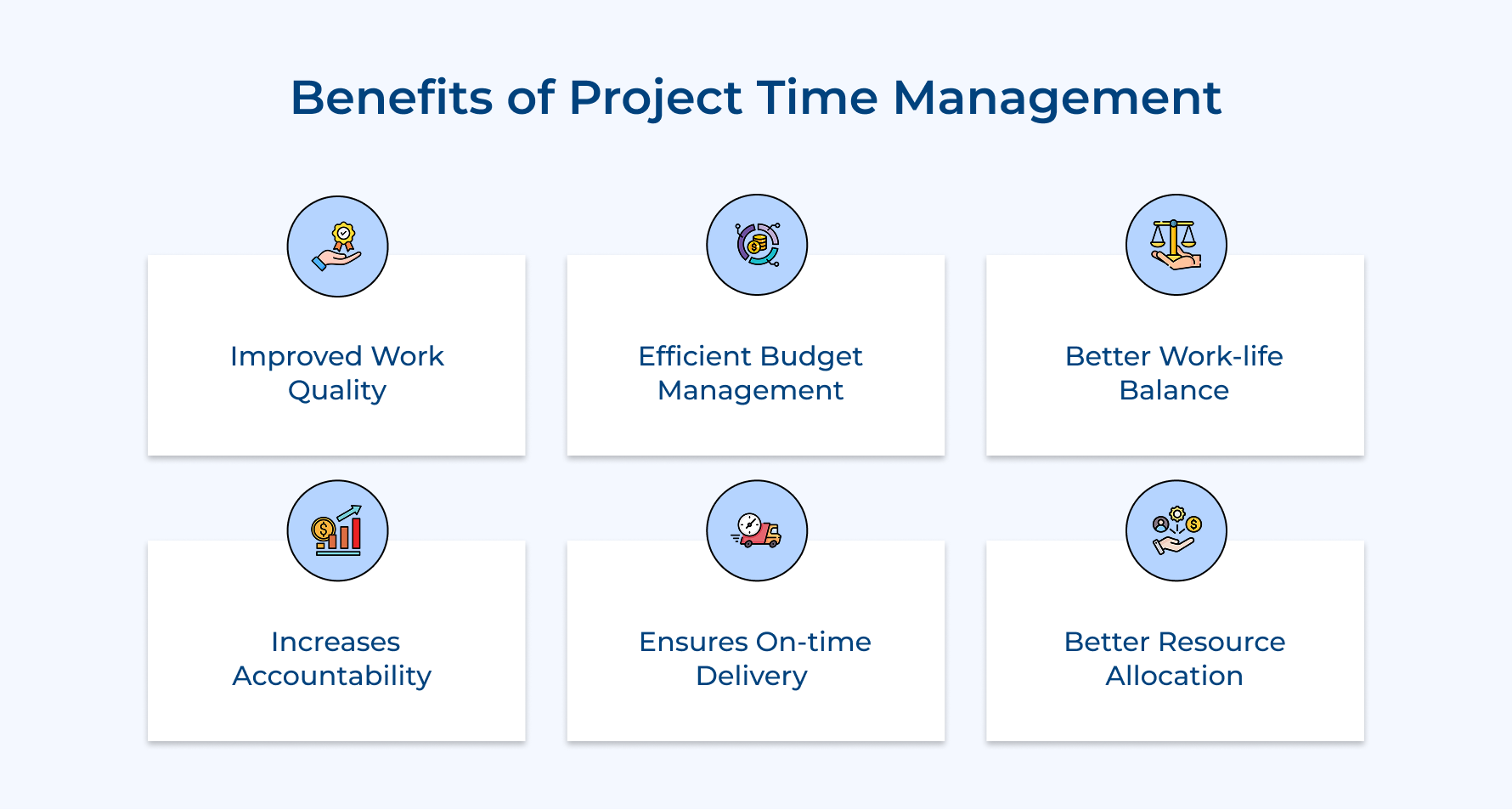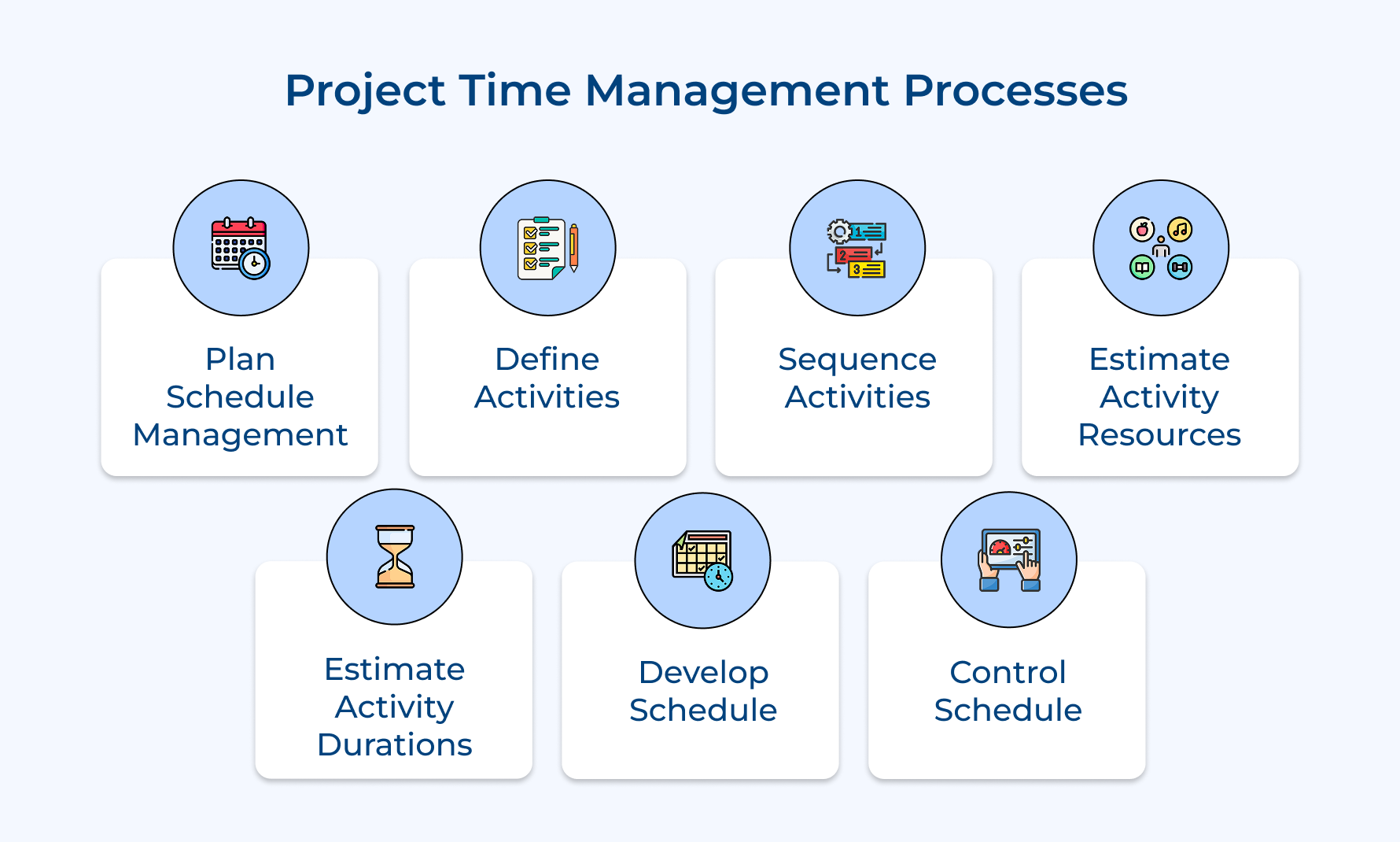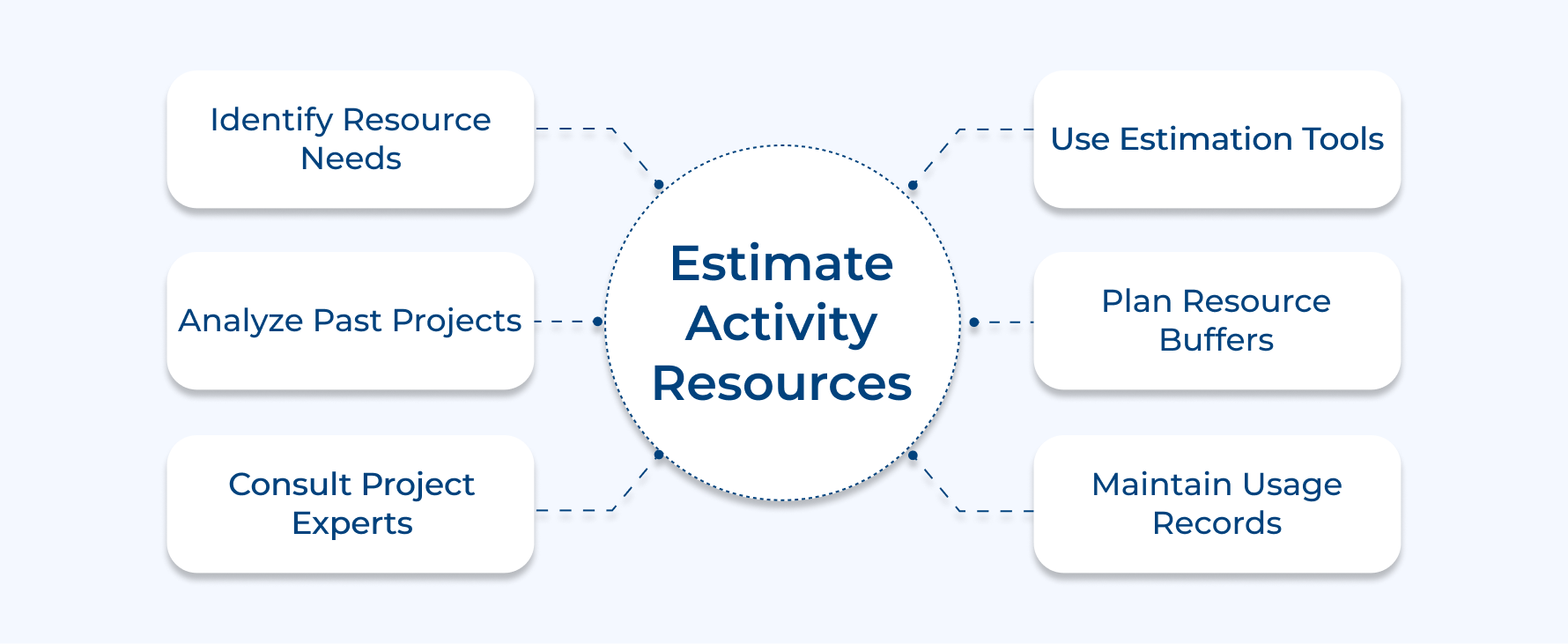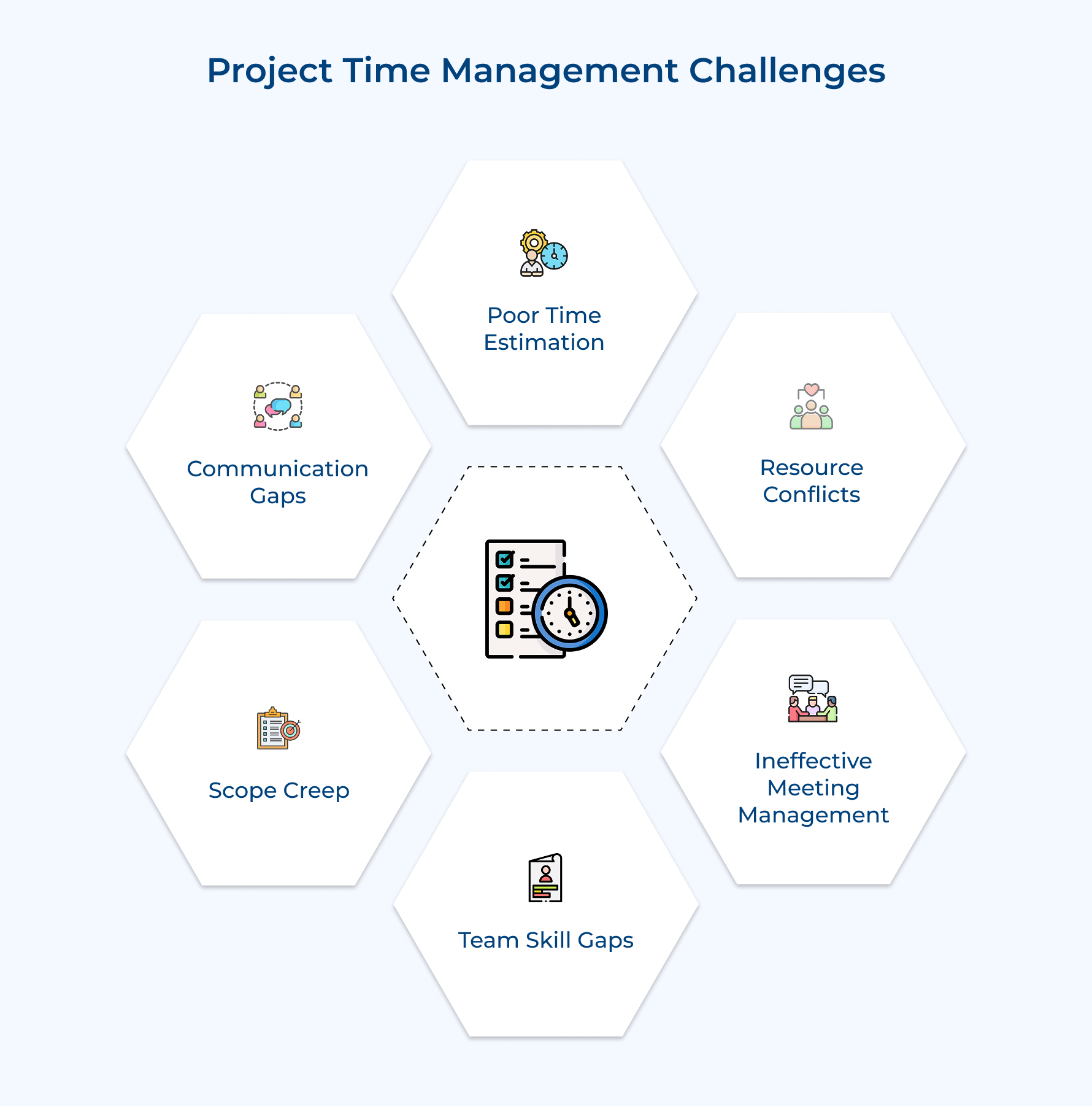A Complete Guide to Understanding Project Time Management
- What is Project Time Management?
- What are the Benefits of Project Time Management?
- Project Time Management Processes: A Detailed Understanding
- Project Time Management Best Practices
- Common Challenges Faced in Project Time Management
- Achieving Project Goals Through Time Management
- FAQs about Project Time Management

Key Highlights:
- Good project time management ensures tasks receive attention, allowing consistent high-quality results.
- Proper time management reduces overtime and avoids unnecessary costs, protecting finances.
- Clear timelines and deadlines create a sense of ownership that motivates teams to complete tasks on time.
Projects running behind schedule? You’re not alone. Recent studies by PMI reveal that 48% of projects miss their deadlines, resulting in budget overruns, stakeholder frustration, and team burnout.
Missing deadlines wreak havoc beyond delayed deliveries—teams become overwhelmed, quality suffers, and costs spiral out of control.
Mastering proven project time management principles transforms delivery outcomes. Professional project managers leverage strategic techniques to meet deadlines consistently.
We’ll reveal battle-tested methods to keep projects on track and stakeholders satisfied.
What is Project Time Management?
Project Time Management definition is the process of planning, estimating, and controlling the time required to complete a project. It involves creating schedules, setting timelines, and ensuring that tasks are completed within the allocated time frame.
Effective time management directly impacts project success by reducing costs, maintaining team productivity, and ensuring stakeholder satisfaction.
When projects stay on schedule, organizations can better manage resources, meet market demands, and keep their competitive edge.
Key objectives:
- Schedule optimization: Establishing realistic timelines and efficient task sequences to minimize project duration while maintaining quality standards.
- Resource efficiency: Ensuring optimal utilization of human and material resources throughout the project lifecycle.
- Risk mitigation: Identifying potential time-related risks early and developing contingency plans to prevent schedule delays.
- Stakeholder satisfaction: Meeting agreed-upon deadlines and maintaining transparent communication about project progress with all stakeholders.
What are the Benefits of Project Time Management?
Effective project time management ensures tasks are completed within deadlines, boosting productivity and minimizing delays. Let’s learn all the other benefits that enhance project management.
Improved Work Quality
Good time management lets teams focus on tasks without feeling rushed to meet deadlines. It ensures every detail gets proper attention, allows for thorough quality checks, and gives room to refine work before submission. An organized approach helps teams consistently deliver top-notch results.
Efficient Budget Management
Managing time strategically goes hand-in-hand with controlling costs. When schedules are on track, there’s less risk of overtime, wasted resources, or penalties for delays. Stick to a well-thought-out timeline to stay within budget and protect the company’s finances.
Better Work-Life Balance
When time is managed well, work schedules become predictable, and the stress of last-minute rushes disappears. Team members can plan their day better, balance their personal and professional lives, as well as enjoy greater job satisfaction.
Increases Accountability
Clear timelines and deadlines make it easy to track performance. When everyone knows their responsibilities and the time they have to deliver, it naturally creates a sense of ownership. People feel more accountable and motivated to complete tasks on time.
Ensures On-Time Delivery
Structured time management in project management means realistic schedules and some buffer time for the unexpected. Teams that plan well consistently meet deadlines, keeping clients happy and building a reputation for reliable delivery.
Better Resource Allocation
Effective time management helps project managers assess what resources are needed and when. It prevents resource conflicts, ensures workloads are balanced and keeps schedules running smoothly. This way, productivity as well as efficiency stay on point
Project Time Management Processes: A Detailed Understanding
Project time management involves a series of structured processes to effectively plan, schedule, and control project timelines. Explore its step-by-step process for smoother implementation.
1. Plan Schedule Management
Planning your project schedule is all about setting the stage for effective timeline management.
Understanding the Basics
- Establishes the methods, tools, and documentation standards for creating as well as controlling project schedules.
- Sets the rules for how schedules will be monitored and adjusted throughout the project lifecycle.
The importance
- Without a proper plan, you risk inconsistent tracking and unclear time management practices.
- A clear schedule management plan ensures everyone is on the same page, reducing confusion and improving teamwork.
How It’s Done
- Teams use standardized templates, scheduling tools, and regular review cycles to stay organized.
- Scheduled reviews, predefined reporting formats, and escalation procedures keep things running smoothly.
Pro Tips for Effective Schedule Management,
- Design templates with clear sections for milestones, dependencies, and resource allocation. Use these templates across all project phases for uniformity.
- Schedule meetings with specific agenda items to discuss timelines and progress.
- Clearly outline all scheduling processes, including how to handle changes.
2. Define Activities
Activity definition is all about identifying and documenting the specific tasks needed to achieve project deliverables. Think of it as breaking down a big, complex project into smaller, manageable chunks with clear starting and ending points.
For instance, if you’re planning a website launch, the larger deliverable might be “Website Development,” and the activities could include tasks like “Design the homepage,” “Develop the contact form,” as well as “Test mobile responsiveness.”
Defining activities clearly will help you eliminate any ambiguity about the project scope. It ensures no critical tasks are overlooked, helping the team understand their roles while enabling accurate resource allocation.
To get this right, project managers often use tools like a Work Breakdown Structure (WBS) to systematically break down deliverables into smaller work packages.
Teams then collaborate during planning sessions to review and refine these tasks, ensuring everything required for the project is covered.
3. Sequence Activities
Activity sequencing is about figuring out the order in which project tasks need to be completed. It involves mapping out logical relationships between tasks and identifying dependencies.
Clear task dependencies ensure smooth transitions between activities, making it easier to allocate resources effectively. This process also helps identify the critical path—the chain of tasks that directly impacts the project’s timely completion.
To manage sequencing, teams often use tools like network diagrams and dependency mapping software to visualize task relationships.
Project managers analyze these diagrams to create efficient schedules and explore opportunities for fast-tracking or compressing timelines.
Pro Tips for Activity Sequencing
- Network diagrams are a great way to map task dependencies visually and spot potential scheduling conflicts before they happen.
- Review critical path activities weekly to ensure they’re prioritized and have the resources needed to avoid delays.
- Clearly outline any dependency assumptions and review them regularly with stakeholders.
4. Estimate Activity Resources
Resource estimation is all about figuring out what you need to get the job done. This includes identifying the type and quantity of materials, equipment, as well as people required for each project task.
Whether it’s internal team members or external resources, having a clear plan ensures everything is in place when you need it.
Here’s why it’s so important and how to do it right:
Why Resource Estimation Matters?
- Ensures all necessary resources are available on time, avoiding delays caused by shortages.
- Optimizes resource allocation across tasks and phases, helping you use what you have more effectively.
How Project Managers Approach It?
- Analyze historical data: Past projects often provide useful insights into resource needs.
- Consult experts: Subject matter experts can help identify specific requirements and offer accurate estimates.
- Use estimation tools: Resource calendars and availability charts help schedule resources at the right time.
Tips for Better Resource Estimation
- Use templates to list skills, equipment, and materials needed for each task. This ensures no detail is overlooked.
- Maintain records of resource usage from past projects to improve accuracy and identify areas for efficiency improvements.
- Plan for the unexpected by adding resource buffers to critical activities. This helps you handle last-minute changes without impacting the timeline.
5. Estimate Activity Durations
Duration estimation projects the time required to complete each activity considering available resources, constraints, and potential risks. It provides the foundation for creating realistic project schedules.
Accurate duration estimates prevent unrealistic schedules and help maintain team morale. They enable better resource planning and provide stakeholders with reliable completion dates for project deliverables.
Teams utilize historical data, expert judgment, and estimation techniques like PERT analysis. Regular reviews and adjustments ensure estimates remain accurate as project conditions change.
Use three-point estimation techniques (optimistic, most likely, pessimistic) to develop more accurate duration predictions. Include team members with relevant experience in estimation processes to leverage their practical knowledge.
6. Develop Schedule
Schedule development is the process of bringing together all the key elements of a project—activity sequences, durations, resources, and constraints—into one cohesive timeline. This timeline serves as the foundation for tracking progress and managing deadlines.
A well-crafted schedule is invaluable for keeping everyone aligned. It provides clear direction for project execution, making it easier to monitor progress and ensure deadlines are met.
Having a detailed timeline, teams can coordinate their efforts effectively, and stakeholders can stay informed about expectations as well as milestones.
Project managers often turn to scheduling software to generate tools like Gantt charts, which visually represent the project timeline. Regular updates and analysis ensure the schedule stays accurate as well as offer opportunities to optimize timelines as the project progresses.
7. Control Schedule
Schedule control involves monitoring project progress, comparing it against the baseline, and implementing necessary adjustments. It ensures the project stays on track and meets timeline objectives.
Regular schedule control helps identify and address delays early before they significantly impact project timelines. It enables proactive management of schedule risks and maintains project momentum.
Teams implement regular progress reviews, earned value analysis, and variance tracking. Schedule updates and corrective actions to maintain alignment with project objectives.
Pro tips for improved schedule control:
- Implement weekly schedule review meetings to track progress and identify potential delays early.
- Use earned value management metrics to objectively measure schedule performance against the baseline.
- Maintain a schedule change log to document and analyze the impact of schedule modifications.
Project Time Management Best Practices
Mastering the project time management process requires strategic planning and disciplined execution to achieve goals. Here are the best practices to help you excel.
Use Time Management Tools
Implement appropriate project management software as well as tools to track schedules, deadlines, and progress. Modern tools offer automation, reminders, and real-time updates, enhancing team collaboration. Effective tool usage streamlines workflow and provides valuable project insights.
Schedule Buffer Time
Include reasonable buffer periods in project timelines to accommodate unexpected delays and challenges. Buffer time prevents cascade effects from minor setbacks and reduces stress on team members. Strategic time buffers maintain project flexibility without compromising delivery dates.
Regular Progress Reviews
Conduct consistent schedule reviews to track advancement, identify potential delays, and implement corrective actions promptly. Regular monitoring enables early problem detection and maintains project alignment with objectives. Progress reviews keep stakeholders informed as well as engaged.
Delegate Effectively
Assign tasks based on team member skills, availability, and workload capacity. Proper delegation ensures efficient resource utilization while also preventing bottlenecks. Match responsibilities with expertise to optimize project time management.
Set Realistic Deadlines
Establish achievable timelines based on accurate effort estimates and available resources. Realistic deadlines maintain team motivation as well as prevent quality compromises. Consider historical data and team input when setting project timeframes.
Monitor Team Workload
Track individual and team capacity to prevent overallocation or even burnout. Balanced workload distribution ensures consistent productivity and quality. Regular workload assessments help maintain optimal resource utilization throughout the project.
Break Down Large Tasks
Divide complex projects into smaller, manageable chunks with specific deliverables and timeframes. Smaller tasks are easier to estimate, track, and complete, reducing overwhelm among team members. Detailed task breakdown improves accuracy in scheduling along with resource allocation.
Common Challenges Faced in Project Time Management
Project time management often encounters countless hurdles. Addressing these challenges proactively is key to keeping projects on track and ensuring successful outcomes.
Poor Time Estimation
Time estimation can go awry when there’s a lack of historical data, too much optimism, or a misunderstanding of task complexity. To improve, try using three-point estimation techniques to get a more balanced view of the time needed.
Keep detailed records of past projects to inform future estimates, and regularly consult subject matter experts. Standardized templates and post-project reviews help refine future estimations while building in contingency time for complex tasks boosts accuracy.
Resource Conflicts
When resources are limited, or team members are overallocated, conflicts can arise, especially when multiple projects are competing for the same resources.
To avoid this implement resource leveling techniques and use centralized resource calendars to track availability. Establish clear prioritization criteria for resource allocation and always have backup plans for critical resources.
Ineffective Meeting Management
We’ve all been in meetings that could’ve been much shorter! Poorly managed meetings waste time and reduce productivity. Combat this by having clear meeting agendas, setting time limits, and inviting only necessary attendees.
Make room for meeting-free periods where the focus can stay on deep work. Consider asynchronous communication when appropriate, and always document the outcomes as well as action items immediately after.
Team Skill Gaps
Skill gaps among team members can cause delays and impact the quality of deliverables. To tackle this, offer targeted training programs, mentorship, and knowledge-sharing sessions.
Create skills development plans that match the project’s needs, and keep a skills inventory to track who has what expertise. Pairing experienced members with those still learning can speed up the process while allowing extra time in the schedule for learning curves.
Scope Creep
Scope creep happens when project requirements expand without control, causing delays and overuse of resources. To prevent this, set up a solid change control process while making sure all changes are formally requested, with a proper impact analysis.
Regular scope reviews and stakeholder alignment meetings will help maintain focus on what’s been approved. Keeping track of what’s in-scope and out-of-scope from the start is key to staying on track.
Insufficient Buffer Time
Not having enough buffer time to accommodate minor setbacks can leave projects vulnerable to delays. Look at historical project data to identify common delay points and add appropriate buffers.
Consider using critical chain project management to pool buffers at strategic points. Have clear buffer management protocols in place, and regularly monitor buffer consumption as the project progresses.
Communication Gaps
Breakdowns in communication can cause confusion and delays in a project. Set up clear communication channels and protocols, while implementing regular status reports.
Use project management tools that allow for real-time updates and create standardized templates for various communication needs. Keeping all documentation centralized and accessible ensures everyone stays in the loop.
Task Dependencies Management
Managing complex task dependencies can be tricky, and if not handled properly, it can cause bottlenecks that delay the entire project. Map out all task dependencies as well as regularly review the critical path. Using project management software can help you visualize and track these relationships.
Have contingency plans for critical tasks and keep an eye on the dependency network to identify potential optimization opportunities. Early warning systems can alert you to dependency-related delays before they become a problem.
Achieving Project Goals Through Time Management
Effective project time management is crucial for delivering projects on time and within budget. It requires thorough planning, accurate time estimations, and continuous monitoring to ensure the project remains on track.
Managing challenges such as scope creep, resource limitations, and unforeseen risks is vital for maintaining progress. Proactive communication with strong leadership helps address these issues. Flexibility is essential, allowing project managers to adjust the schedule as needed to keep the project moving forward.
Implementing best practices like realistic goal setting and using appropriate tools helps optimize team productivity. Mastering time management leads to greater project success, improved stakeholder satisfaction, and a stronger reputation for consistently delivering results.
Limit time — not creativity
Everything you need for customer support, marketing & sales.
Neeti Singh is a passionate content writer at Kooper, where he transforms complex concepts into clear, engaging and actionable content. With a keen eye for detail and a love for technology, Tushar Joshi crafts blog posts, guides and articles that help readers navigate the fast-evolving world of software solutions.



